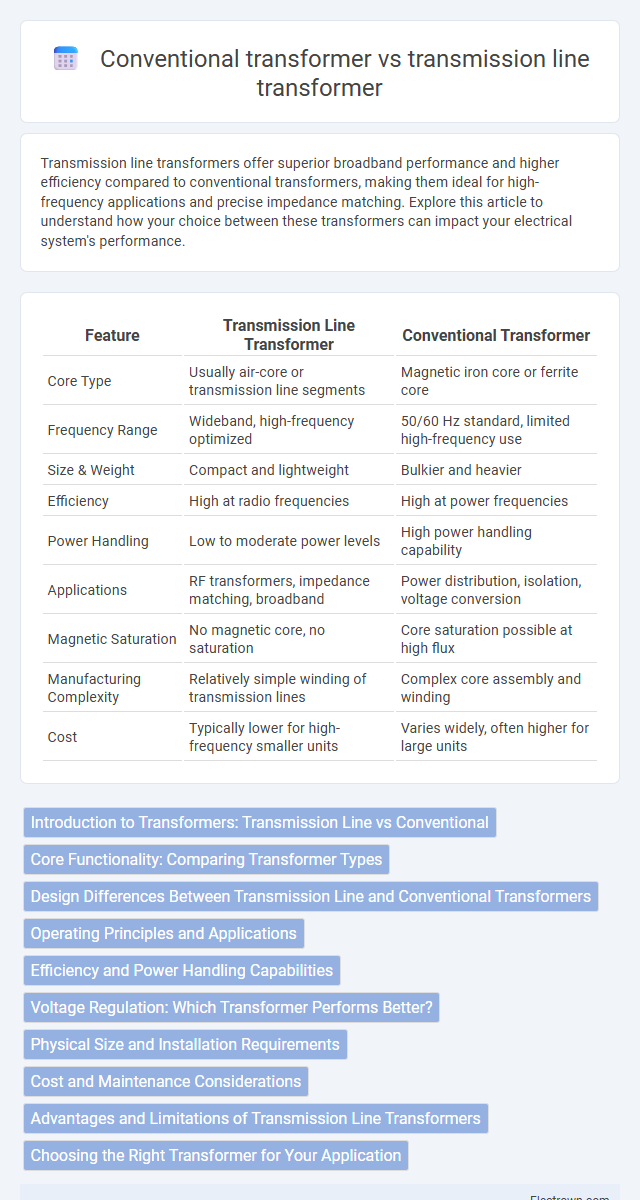Transmission line transformers offer superior broadband performance and higher efficiency compared to conventional transformers, making them ideal for high-frequency applications and precise impedance matching. Explore this article to understand how your choice between these transformers can impact your electrical system's performance.
Table of Comparison
| Feature | Transmission Line Transformer | Conventional Transformer |
|---|---|---|
| Core Type | Usually air-core or transmission line segments | Magnetic iron core or ferrite core |
| Frequency Range | Wideband, high-frequency optimized | 50/60 Hz standard, limited high-frequency use |
| Size & Weight | Compact and lightweight | Bulkier and heavier |
| Efficiency | High at radio frequencies | High at power frequencies |
| Power Handling | Low to moderate power levels | High power handling capability |
| Applications | RF transformers, impedance matching, broadband | Power distribution, isolation, voltage conversion |
| Magnetic Saturation | No magnetic core, no saturation | Core saturation possible at high flux |
| Manufacturing Complexity | Relatively simple winding of transmission lines | Complex core assembly and winding |
| Cost | Typically lower for high-frequency smaller units | Varies widely, often higher for large units |
Introduction to Transformers: Transmission Line vs Conventional
Transmission line transformers utilize the properties of transmission lines, employing distributed inductance and capacitance to achieve impedance transformation with minimal leakage inductance and wide bandwidth. Conventional transformers rely on magnetic cores and coil windings to transfer energy through electromagnetic induction, often resulting in larger size and frequency limitations. Your choice depends on application requirements such as frequency range, size constraints, and efficiency needs.
Core Functionality: Comparing Transformer Types
Transmission line transformers utilize distributed inductance and capacitance along a transmission line to achieve impedance transformation with wider bandwidth and lower loss, making them ideal for RF and high-frequency applications. Conventional transformers rely on magnetic cores to transfer energy through electromagnetic induction, providing efficient voltage conversion at power frequencies but often exhibiting higher core losses and limited bandwidth. Your choice depends on the specific frequency range and efficiency needs, with transmission line transformers offering superior performance in broadband, high-frequency environments.
Design Differences Between Transmission Line and Conventional Transformers
Transmission line transformers utilize distributed transmission line sections to achieve wide bandwidth and minimal signal distortion, contrasting with conventional transformers that rely on magnetic cores and wire windings for energy transfer. The design of transmission line transformers emphasizes impedance matching and phase coherence over broad frequency ranges, while conventional transformers primarily focus on magnetic flux coupling and core saturation limits. Key materials in transmission line transformers include coaxial cables or stripline structures, whereas conventional transformers use laminated ferromagnetic cores and copper windings.
Operating Principles and Applications
Transmission line transformers rely on transmission line segments to achieve impedance transformation through electromagnetic wave propagation, offering broadband performance and compactness compared to conventional transformers that use magnetic cores and rely on inductive coupling. Transmission line transformers are ideal for radio frequency (RF) and high-frequency applications including impedance matching and signal isolation, while conventional transformers excel in low-frequency power distribution and voltage conversion tasks. Your choice depends on operating frequency, size constraints, and application requirements, with transmission line transformers favored in advanced communication systems and conventional transformers dominating electrical power grids.
Efficiency and Power Handling Capabilities
Transmission line transformers offer higher efficiency and superior power handling capabilities compared to conventional transformers due to their low loss design and better impedance matching. Your power system can benefit from reduced energy dissipation and improved performance, especially in high-frequency or broadband applications. Conventional transformers may struggle with efficiency at higher frequencies and have limited power handling due to core saturation and increased losses.
Voltage Regulation: Which Transformer Performs Better?
Transmission line transformers typically exhibit superior voltage regulation compared to conventional transformers due to their low leakage inductance and minimal parasitic capacitance, resulting in more stable output voltage under varying load conditions. Conventional transformers often experience greater voltage drops and fluctuations because of higher winding resistance and reactance. For applications demanding precise voltage stability, your choice of a transmission line transformer offers enhanced performance and efficiency.
Physical Size and Installation Requirements
Transmission line transformers offer a compact physical size compared to conventional transformers, making them ideal for applications with limited space. Their simplified installation process requires less room and fewer mounting constraints, streamlining integration into your system. Conventional transformers typically demand larger footprints and more robust structural support, increasing installation complexity and space requirements.
Cost and Maintenance Considerations
Transmission line transformers generally offer lower maintenance costs due to their simpler construction and fewer winding components compared to conventional transformers. Conventional transformers often require regular inspections and oil replacements to prevent insulation degradation, increasing maintenance expenses over time. The initial cost of transmission line transformers tends to be higher, but their durability and reduced upkeep can lead to lower total cost of ownership in long-term applications.
Advantages and Limitations of Transmission Line Transformers
Transmission line transformers offer advantages such as wide bandwidth, compact size, and low insertion loss compared to conventional transformers, making them ideal for high-frequency and RF applications. Their limited power handling capacity and potential for impedance mismatch are notable limitations that may affect performance in certain scenarios. You can optimize your system design by carefully considering these trade-offs for efficient signal coupling and impedance transformation.
Choosing the Right Transformer for Your Application
Transmission line transformers offer superior broadband performance and compact size compared to conventional transformers, making them ideal for high-frequency or RF applications. Conventional transformers excel in handling high power levels and low-frequency signals, providing robust insulation and voltage isolation. Selecting the right transformer depends on factors such as operating frequency, power requirements, impedance matching, and physical size constraints specific to your application.
Transmission line transformer vs conventional transformer Infographic

 electrown.com
electrown.com